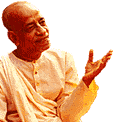Chapter 4: Transcendental Knowledge
Bg 4.27
TEXT 27
sarvanindriya-karmani
prana-karmani capare
atma-samyama-yogagnau
juhvati jnana-dipite
prana-karmani capare
atma-samyama-yogagnau
juhvati jnana-dipite
SYNONYMS
sarvani—all; indriya—senses; karmani—functions; prana-karmani—functions of the life breath; ca—also; apare—others; atma-samyama—controlling the mind; yoga—linking process; agnau—in the fire of; juhvati—offers; jnana-dipite—because of the urge for self-realization.
TRANSLATION
Those who are interested in self-realization, in terms of mind and sense control, offer the functions of all the senses, as well as the vital force [breath], as oblations into the fire of the controlled mind.
PURPORT
The yoga system conceived by Patanjali is referred to herein. In the Yoga-sutra of Patanjali, the soul is called pratyag-atma and parag-atma. As long as the soul is attached to sense enjoyment, it is called parag-atma. The soul is subjected to the functions of ten kinds of air at work within the body, and this is perceived through the breathing system. The Patanjala system of yoga instructs one on how to control the functions of the body's air in a technical manner so that ultimately all the functions of the air within become favorable for purifying the soul of material attachment. According to this yoga system, pratyag atma is the ultimate goal. This pratyag atma is a withdrawal from activities in matter. The senses interact with the sense objects, like the ear for hearing, eyes for seeing, nose for smelling, tongue for tasting, hand for touching, and all of them are thus engaged in activities outside the self. They are called the functions of the prana-vayu. The apana-vayu goes downwards, vyana-vayu acts to shrink and expand, samana-vayu adjusts equilibrium, udana-vayu goes upwards—and when one is enlightened, one engages all these in searching for self-realization.
Copyright (c) 1972 by His Divine Grace A.C. Bhaktivedanta Swami Prabhupada











